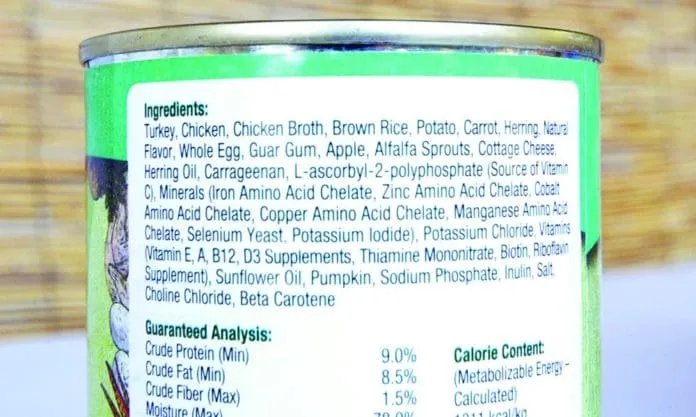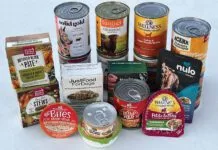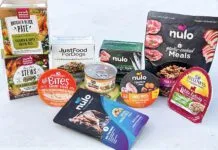[Updated February 24, 2016]
Traits of a Good Wet Dog Food
The highest possible inclusion of top-quality animal proteins. Look for a whole, named source of meat as the first ingredient (meaning the product contains more of that ingredient by weight than anything else). There are some good foods that list water or broth as the first ingredient and a meat ingredient second – but we’d choose a product with meat first on the label over one that listed meat second.

“Named” sources of any animal protein or fat, whether it’s a muscle tissue (in which case it will appear as chicken, beef, buffalo, etc.) or an organ meat (in which case it should specify which species it came from, for example, “beef liver”).
Whole grains or vegetables (if any are used in the formula).
Limited (if any) use of grain or vegetable by-products. For example, a food containing potato starch as the sixth ingredient would be preferable to one with the same ingredient in the third position on the ingredients panel. And a food that contained just one grain or vegetable by-product (such as oat bran) would be preferable to a product containing several (such as potato starch, oat fiber, and tomato paste).
The words “complete and balanced.” Some manufacturers produce a few wet food products that are meant for “supplemental or intermittent” use only. These products do not meet the specifications for a “complete and balanced diet” as defined by the model regulations developed by the Association of American Feed Control Officials (AAFCO) and adopted by each state. While these “supplemental” foods may be useful as part of a varied diet, they can’t be relied on to provide all the nutrients your dog needs.
Traits of Low-Quality Wet Foods
Unnamed animal sources, such as meat, meat by-products, poultry, poultry by-products, or animal fat.
Meat by-products or poultry by-products. There is a wide range in the quality and type of by-products that are available to pet food producers. And there is no way for a dog owner (or anyone else) to find out whether the by-products used are kept clean, chilled, and used fresh within a day or two of slaughter (as some companies claim), or are comprised of ingredients that were literally swept off a floor, dumped down the floor drains at the processing plant, and kept for hours or days on unrefrigerated loading docks and trucks. Because you can’t know, avoid by-products.

Wheat gluten. Wet foods often contain some sort of thickener or binder. Various types of “gum” (such as guar gum, from the seed of the guar plant, and carrageenan gum, from seaweed) are common thickeners. Whole grains, potatoes, and sweet potatoes also can be used to thicken wet food. But wheat gluten (and some other glutens) are generally used in wet foods both to augment the protein content of the food (albeit with lesser quality amino acids) and to act as a binder, to hold together artificially formed “chunks” so that they resemble chunks of meat. In other words, it’s a signal that the real meat content of the product is less than ideal. If chunks of meat are present in a wet dog food, they should be actual chunks of meat.
Sugar or other sweeteners. A food that contains quality meats shouldn’t need additional palatants to entice dogs.
Artificial colors, flavors, or added preservatives. Fortunately, these are rare in wet foods!
Pet Food Brand Examples
This one is easy.

This is Beneful’s “Savory Rice & Lamb Stew,” and it’s chock full of the “traits to avoid.” We won’t hold the fact that water is the first ingredient against the product; there are good foods with water as the first ingredient, too. But wheat gluten is the second ingredient. WOW. Think about that: By weight, there is more wheat gluten in this food than meat – which is crazy, because meat is full of moisture, which is heavy!
There are more “traits to avoid,” too: meat by-products (could be anything); “liver” (no species named); artificial and natural flavors (if the food contained a lot of meat, the maker wouldn’t need to add flavors to make it palatable); and added color (to make it pretty for you!).
Any “desirable traits”? Lamb and chicken are in there, but since they appear 6th and 8th on the label, their contributions are actually not very significant. Same goes for wild rice, peas, and carrots; appearing in the 9th, 10th, and 11th spots on the label, they aren’t contributing much.
Here is one of those mixed bags of good and undesirable traits.

This is Iams’ “Proactive Health Chunks with chicken in Gravy” and the ingredients start out nicely: Water (okay), chicken (great!), and then meat by-products and chicken by-products (sigh). Check out the addition of broccoli and spinach, way down under all the vitamins and minerals. Why bother, at that level of inclusion? (We can’t even imagine what such a tiny amount of broccoli and spinach would look like in a cooking vat full of this food!)
This next one is one of our approved canned foods.

It is Natural Balance’s “Limited Ingredient Diets Chicken & Sweet Potato Formula.” It has a lot going for it, including the fact that chicken appears first on the ingredients list, and the moisture (2nd) that’s been added for processing purposes is chicken broth: nice! Look what’s next, however: sweet potatoes, potatoes, and dehydrated potatoes. By the time you add up all that potato, does it outweigh the animal protein (even with chicken liver and chicken meal in 6th and 7th positions)?
One more thing. Look a little lower on the label, at the guaranteed analysis: The fat content is just 3.5 percent. That may make it highly appropriate for dogs who need a lower-fat food. And this is why you need to be aware of how much fat and protein you currently feed your dog, whether or not he needs to gain, hold, or lose weight, and given those factors, what effect this product may have if added to his diet.
Here is another one of our approved canned foods.

This is Natura Pet Product’s Innova. We love that there are two whole, named meats first on the ingredients list, and that the moisture that has been added (3rd) is chicken broth. There are more carbohydrates in here than there needs to be (brown rice, potato, carrot), but they are all whole and not repetitious (like when you see brown rice and white rice in the same formula), so as long as they work for the dog we are feeding, we’re fine with that.
However, look sharp: Check out that fat content, a whopping 8.5 percent! That might be super for your working Border Collie or field hunter, or a major problem for your Poodle with pancreatitis. Always read the label!
In the “Whole Dog Journal’s 2012 Canned Dog Food Review“ you will find a list of companies that make foods that meet all of our selection criteria for healthy, high-quality canned foods. Again, they all make great foods, but not all of the foods they make are appropriate for every dog, so check the ingredients panel and guaranteed analysis for every variety you consider feeding to your dog. The list is ordered alphabetically by the manufacturer, so if you don’t see the name of your favorite food, look at the label of the food to see what company makes it! As you try different products, keep track of your dog’s weight, and adjust the type and amount of food you feed accordingly.








